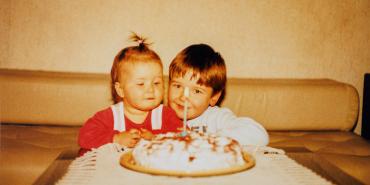Gift-Wrapped

My favorite part of the Christmas tradition is giving. Sometimes my search to find that perfect gift for my husband, children, and grandchildren can take all year. I enjoy wrapping the presents in bright paper and color-coordinated, wire-edged ribbon. The beauty of the presentation becomes a part of my gift.
That's why I don't understand why the gift of the Christ Child came wrapped in what I'd call plain brown paper. If I had been in control, that big event would have been wrapped extravagantly.
First of all, I would have been sure the mother-to-be met this stringent list of requirements:
- From a prominent family in the line of David.
- Lived in Jerusalem, the City of God.
- Was a member of the richest Jewish family in town.
- Had refined manners reflecting a quality education.
Instead, Mary was probably a young peasant woman with a simple lifestyle, betrothed to a carpenter from the unimportant Galilean village of Nazareth. She found favor with God and bore his Son. Her obedient response to the angel's message helps explain God's choice: "I am the Lord's servant" (Luke 1:38).
Next, I would have carefully managed Mary's prenatal care to include:
- Pampering from the moment she announced her pregnancy. No more carrying home heavy water pots from the well down the road. Her every whim would have been fulfilled.
- Regular check-ups with the town's best midwife. Everything possible would be done to guarantee a healthy fetus and normal birth with minimal pain.
- As the time for her delivery grew near, Mary would be required to remain close to her home, ready to call for the midwife-or at least her mother-at the first signs of labor.
But that's not what happened. After the angel's visit, Mary rushed off to Judea to be with her cousin Elizabeth for three months. The journey from Nazareth probably took three days. Those would not have been three restful months for Mary. Elizabeth, an older woman, was in the third trimester of pregnancy with her son, who would come to be known as John the Baptist. Surely Mary coddled Elizabeth-not the other way around.
Mary returned to Nazareth after John's birth. But as the delivery time for her own child drew near, her husband Joseph needed to register for the census in his family's hometown (Luke 2:4). So Joseph and Mary hit the dusty, 90-mile trail for Bethlehem, probably with her jiggling and joggling along on a donkey.
Finally, I would have staged the events surrounding Jesus' birth like an Olympic extravaganza. The details would have included:
- A suite in a five-star hotel reserved for Mary upon her arrival in Bethlehem. And don't forget the welcoming flowers and chocolates in the room.
- The finest obstetricians and nurses on call to deliver the baby in the best-equipped medical facility in town.
- Pediatricians prepared for any emergency, waiting to bathe, weigh, and examine the newborn infant.
- Local dignitaries ready to converge on the hospital immediately after the birth to offer their congratulations.
- The scribes and the runners-the media of the day-notified that the Messiah's birth was imminent. News of the arrival would have been quickly announced throughout the kingdom. Within 24 hours, the miniscule details of the delivery would have been commonly known in the surrounding marketplaces and synagogues.
- Multiple gifts would have poured in from the rich and famous.
- Jesus' cradle would have been constructed from the best-quality wood. Closets and drawers in his beautifully designed room would have been stuffed with designer baby clothes.
Instead, an obscure couple stumbled into a town crammed with travelers, with no rooms vacant in any decent inns. They only found a place to sleep in a smelly stable. There-without her mother's presence-Mary gave birth, wrapped her newborn son in swaddling clothes, and laid him in a manger (Luke 2:7).
What's worse, shortly after Jesus' birth, a bunch of ragtag shepherds, possibly reeking of sweat and sheep's wool, blundered into the stable cave. After paying homage to Jesus, the shepherds circulated throughout the neighborhood and proclaimed that Christ the Lord had just been born (Luke 2:17-18). It was a public relations nightmare. No one could verify their strange story about the angels serenading them from the heavens and directing them to Bethlehem to worship the Christ Child. Surely the people wondered what those uneducated men could possibly know about the birth of God's Son.
Two years passed before the baby received gifts worthy of mention-and those came from wise men that weren't even related to the family and had no local influence.
But wait! Perhaps I should look again at God's gift presentation. Maybe time needed to pass before we could fully comprehend Jesus' birth packaging. It took 33 years for history to reveal that God's Christmas gift included not just the birth, but also the death and resurrection of His Son. Maybe the gift of Jesus' birth wasn't packaged in plain brown paper. In John 6:40 Jesus says, "For my Father's will is that everyone who looks to the Son and believes in him shall have eternal life."
God's wonderful Christmas gift is actually wrapped in His self-giving love, and is available to us all.
Pat Stockett Johnston is a freelance writer and speaker who served for 20 years as a missionary in the Middle East.
Please note: All facts, figures, and titles were accurate to the best of our knowledge at the time of original publication but may have since changed.




